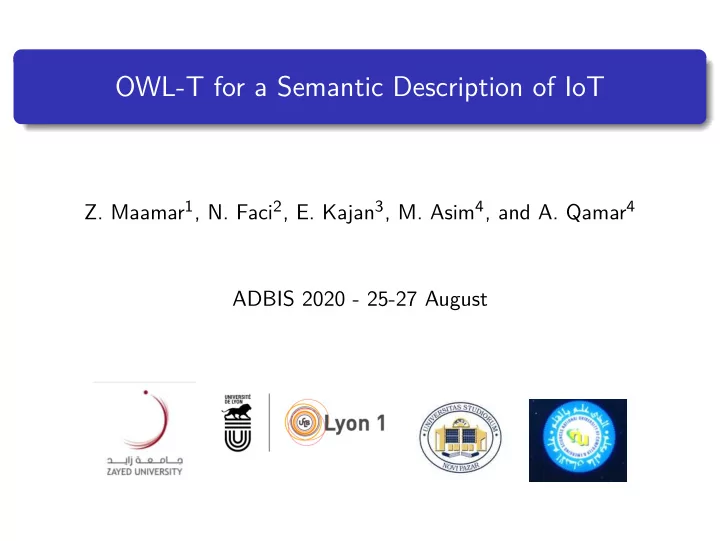

OWL-T for a Semantic Description of IoT Z. Maamar 1 , N. Faci 2 , E. Kajan 3 , M. Asim 4 , and A. Qamar 4 ADBIS 2020 - 25-27 August
Outline Introduction 1 Related work 2 Contributions 3 Conclusion 4
Outline Introduction 1 Related work 2 Contributions 3 Conclusion 4
IoT Context & Challenges Ever-growing number of things Figure: Gartner estimation (2021): 20.8 Billion things However, same challenging concerns as Web services technologies: description, discovery, composition, cognition, vetting, and many others. ⇒ Importance of semantically describing things in preparation for their discovery and then, composition into complex business scenarios. Z. Maamar et al. OWL-T for a Semantic Description of IoT 1 / 11
Outline Introduction 1 Related work 2 Contributions 3 Conclusion 4
Related work on semantic IoT Some approaches describe things for semantic interoperability ⇒ Necessary but not sufficient for service discovery and composition. Others describe things for semantic discovery and composition - Things as Services - Things as Resources ⇒ Not exhaustive description of things Z. Maamar et al. OWL-T for a Semantic Description of IoT 2 / 11
Outline Introduction 1 Related work 2 Contributions 3 Conclusion 4
Contributions Resort to the well-defined standard OWL-S (Ontology Web Language for Services) to develop our Ontology Web Language for Things (OWL-T). • Semantic description of things from 3 dimensions: interaction, consumption, and operation • Concepts to answer 5 questions related to thing discovery: with whom does a thing interact? 1 what resources does a thing consume? 2 what does a thing do? 3 how does a thing work? 4 how is a thing invoked? 5 Z. Maamar et al. OWL-T for a Semantic Description of IoT 3 / 11
OWL-T’s Overview Interaction� Consumption� Cloud� dimension� dimension� Logical� Fog� thingNode� thingResource� Physical� consumes� interacts� Thing (peer)� Thing� described by� Operation� dimension� exposes� supports� Public� thingModel� thingProfile� thingGrounding� Technology� (duty)� Private� Sensing� Actuating� Sensing� Atomic� Composite� Sensing� Communicating� Actuating� Actuating� Communicating� Communicating� Sensing� Legend� Actuating� Conceptual area� Concrete area� Instantiates� Communicating� Z. Maamar et al. OWL-T for a Semantic Description of IoT 4 / 11
Interaction dimension Shed light on the stakeholders that form a thing’s ecosystem and hence, will engage in interactions with the thing. Node� textDescription� nodeCloseness� thingNode� nodeName� Peer� Fog� Cloud� Legend� Subclass� ObjectProperty� DatatypeProperty� Figure: OWL-T interaction representation Z. Maamar et al. OWL-T for a Semantic Description of IoT 5 / 11
Operation dimension Shed light on the capabilities of a thing in terms of • What they do - thingModel (duty) • How they do what they do - thingProfile • How they are deployed - thingGrounding What are a thing’s duties? Thing� is meant for� sensing� actuating� communicating� e x c h a n g e � e x c h a n g e � (0,1)� (0,1)� (0,1)� e x c h a n g e � Figure: Representation of a thing’s atomic duties Z. Maamar et al. OWL-T for a Semantic Description of IoT 6 / 11
Operation dimension - Thing Model What things do Model� corresponds� thingModel� Duty� sc� Sensing (s)� sac� Communicating� Atomic� Composite� (c)� ..........� composedOf� Actuating (a)� Legend� ac� Subclass� ObjectProperty� Chronology� DatatypeProperty� Figure: OWL-T model representation Z. Maamar et al. OWL-T for a Semantic Description of IoT 7 / 11
Operation dimension - Thing Profile How things do what they do Profile� refersTo� thingProfile� Duty� h a s Q o T � textDescription� Private� Public� qualityOfThing� QoTCategory� Legend� Subclass� ObjectProperty� DatatypeProperty� Figure: OWL-T profile representation Z. Maamar et al. OWL-T for a Semantic Description of IoT 8 / 11
Operation dimension - Thing Grounding How things are deployed Grounding� textDescription� implementedWith� thingGrounding� iotTechnology� technologyName� Actuator� Sensor� Communicator� Legend� Subclass� ObjectProperty� DatatypeProperty� Figure: OWL-T grounding representation Z. Maamar et al. OWL-T for a Semantic Description of IoT 9 / 11
Consumption dimension Shed light on the resources that a thing requires so that the thing functions with respect to the respective needs of the interaction and operation dimensions. Limited� Renewable� Non-Shareable� Resource� consumption� Property� h Flex+� a s C o n s u m p t i o n textDescription� P r o p e r t y � hasPrice� hasState� Saver� Price� thingResource� currentState� hasChange� hasRefund� resourceName� Flex� hasIP� &expr;#IP� Logical� Physical� useLevel� hasUseLevel� changePolicy� refundPolicy� Legend� Subclass� ObjectProperty� DatatypeProperty� Figure: OWL-T consumption representation Z. Maamar et al. OWL-T for a Semantic Description of IoT 10 / 11
Outline Introduction 1 Related work 2 Contributions 3 Conclusion 4
Conclusion To sum-up • A comprehensive description of things in terms of with whom they interact, what resources they consume, what they do, how they work, and how they are invoked. • A novel ontology OWL-T to allow injecting semantics into IoT. Future work • Technically demonstrate OWL-T through a case study. • Examine OWL-T-based thing composition in compliance with the interaction dimension. Z. Maamar et al. OWL-T for a Semantic Description of IoT 11 / 11
Recommend
More recommend